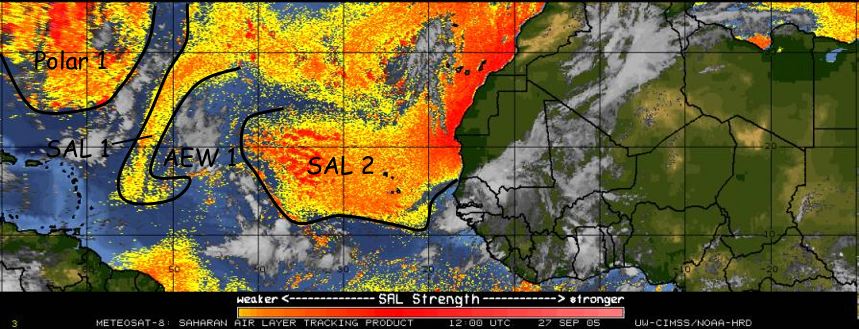
Fig. 1: G-IV light track (green line) for SALEX mission 050927N. The GPS dropsonde points (24 total) are indicated by green circles.
| Aircraft Crew (49RF) | |
| Aircraft Commander | Mark Fink |
| Pilots | Michele Finn Jeff Hagan |
| Project Manager | Jack Parrish |
| Flight Meteorologist | Paul Flaherty |
| Equipment Specialist | Gordon Kitson |
| Electronics Technician | Dave Brogan |
| Electronics Technician | Dale Carpenter |
| Electronics Technician | John Hill |
| Scientific Crew (49RF) | |
| Sonde Scientist | Jason Dunion |
Mission Plan :
NOAA 49RF will fly a Saharan Air Layer Experiment through an African easterly wave (AEW) and two SAL airmasses as part of IFEX. The G-IV will leave Barbados at 1450 UTC and will recover back at Barbados at 2200 UTC. The flight track will take the G-IV east through an area of 'older' Saharan Air Layer (SAL) air, an AEW axis at ~47°W, and finally through a 'newer' SAL outbreak. These areas and the moist tropical air south of these features will be sampled on the return east-west leg. The flight track and 24 dropwindsonde points are shown in Fig. 1.

Mission Summary :
a) Synoptic Situation A large SAL outbreak moved off the African continent on 20 September and by the next day, had pushed as far west as ~30°W (Fig. 2a, SAL 1). An AEW closely followed this SAL outbreak, emerging from the coast of North Africa on 22 September (Fig. 2b, AEW 1). As AEW 1 moved across the basin over the next several days, its northwest heading brought it into the SAL and it struggled to intensify (Fig. 2c & d). Early on 26 September, it was determined that the series of SAL outbreaks and the embedded AEW presented a good case for SALEX and the G-IV was deployed to Barbados.




Fig. 2: Meteosat-8 SAL imagery (21-27 September 2005) showing two large
SAL outbreaks (SAL 1 & 2) separated by an AEW (AEW 1). Yellow to red
shading indicates areas of dry (and possibly dusty) air in the lower to
middle troposphere (~600-925 hPa).
On the morning of the mission, the AEW axis was located at ~47°W) and the Meteosat-8 SAL imagery indicated that the environment around the wave was fairly moist in the lower to middle levels (Fig. 2d). Although there was some convection associated with this AEW, there were no areas of concentrated deep convection. However, 850 hPa vorticity analyses from UW-CIMSS did show that there was a broad area of relative vorticity associated with this AEW from ~10-20°N and ~40-50°W (Fig. 3).

b) Mission Specifics The flight pattern was designed to investigate several specific areas (Fig. 4):

Takeoff was at 1450 UTC from Barbados. The flight plan called an optimal flight level of 41,000-45,000 ft and required that all dropwindsondes be transmitted in real-time, so that the humidity data from the sondes could be included in parallel runs of the NOAA GFS model. The initial flight pattern involved a short northeast leg from Barbados to the IP at ~14°N 58°W. The initial drops targeted the leading area of dry SAL air (SAL 1) ahead of AEW 1 (drops 1-5) and the moisture gradients along its boundaries (drops 5-7). The next several drops sampled the moist environment of the AEW (drops 6-11) and the transitional environment between it and the next SAL outbreak [(SAL 2), drops 11-13]. Drops 13-17 sampled SAL 2 and the northern edge of the convective area that stretched along ~10°N along the southwest leading edge of SAL 2. The remainder of the drops (drops 18-24) sampled the moist tropical environment south of SAL 1, AEW 1, and SAL 2. This last series of drops showed that although the lower to middle troposphere was quite moist along this transect, the middle to upper troposphere (~400 hPa–flight level) was very dry. The environment of SAL 2 was noted to be extremely dry and dusty, with strong temperature inversions capping the top and bottom layers of the SAL. Dropwindsondes in SAL 2 (drops 13-17) indicated the following:


Problems :
There were no major problems related to this flight. The vintage 2000 GPS dropsondes that were used did, however, have a fairly high failure rate (~30% or 10 failed dropwindsondes out of 33 deployed).
Jason Dunion
Principal Investigator
|
Aircraft: N49RF Altitude: FL410-450 Takeoff: 27/1450Z | |||
| Drop # | Lat (degrees) | Lon (degrees) | UTC time |
| 1 | 14.005 | 57.821 | 1517 |
| 2 | 14.020 | 57.174 | 1522 |
| 3 | 14.040 | 56.520 | 1527 |
| 4 | 14.076 | 53.821 | 1548 |
| 5 | 14.087 | 50.772 | 1610 |
| 6 | 14.083 | 49.994 | 1616 |
| 7 | 14.059 | 47.820 | 1633 |
| 8 | 14.004 | 44.823 | 1657 |
| 9 | 14.043 | 41.996 | 1720 |
| 10 | 14.050 | 40.804 | 1730 |
| 11 | 14.050 | 39.455 | 1741 |
| 12 | 14.050 | 38.420 | 1750 |
| 13 | 14.036 | 37.264 | 1800 |
| 14 | 14.020 | 36.120 | 1810 |
| 15 | 13.010 | 35.000 | 1827 |
| 16 | 12.060 | 35.060 | 1834 |
| 17 | 12.163 | 38.005 | 1858 |
| 18 | 12.254 | 40.012 | 1914 |
| 19 | 12.460 | 46.999 | 2009 |
| 20 | 12.496 | 49.996 | 2033 |
| 21 | 12.561 | 50.996 | 2042 |
| 22 | 12.503 | 51.997 | 2050 |
| 23 | 12.520 | 53.201 | 2100 |
Page last updated January 24, 2006
Return to Mission page.